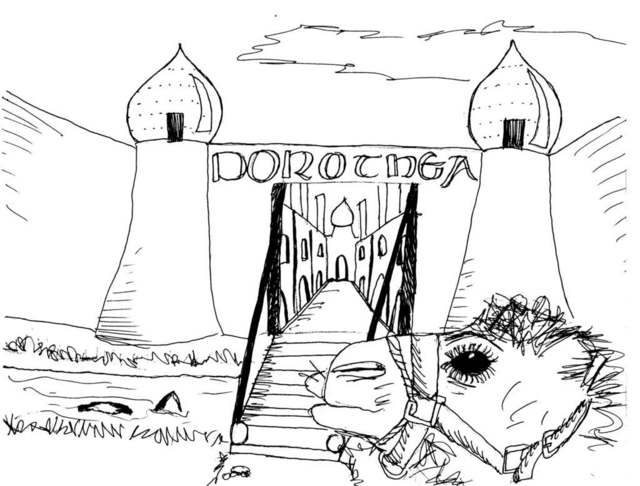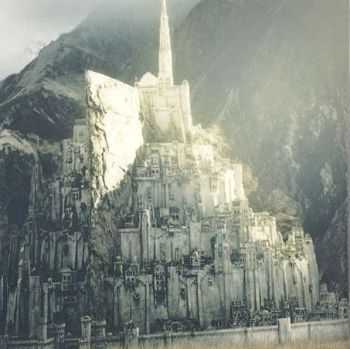Stipulation for the record: I am not an artist, but Dorothea was my choice because:
a) My grandmother's name was Dorothy.
b) My birth stone is amethyst.
c) I like the idea that Dorothea opened many paths for Marco Polo.
James

Calvino’s city of Zaira seems to struggle between the present and the past, between the individual and the universal, between the personal and the concrete. The exact number of steps, degree of curves of an arcade, the height of a lamppost are stagnant aspects of a city; these measurements remain the same for each person who views them. However, they become part of a city’s memory, past and therefore present, as each individual interacts with these concrete items in a different way, as each individual personalizes these items and the city.
To me, this same interplay between past and present can be seen in Rome. Just as with Zaira, Rome’s present is a made up of its past, which might not “tell its past, but contains it like the lines of a hand, written in the corner of the streets…” The attempt for modernity in Rome seems to conflict with the visible archaeological past. For example, the city’s effort to build a new subway line, modernizing the city, can only be started once the proposed tunnels and path have been thoroughly investigated for any archaeological remains; there are numerous signs up in the center of Rome announcing “Metro C investigates archaeology.” The present in Rome has to, out of respect and by law, pay heed to the past; the concrete, the measurements of the city can only be determined now in accordance with the past.
Claudia
Despina is a dual natured city in that it is both on the desert and on the sea, and that it evokes two distinct impressions of what travelers will encounter depending on which direction they come from. I love the imagery of the two different Despinas, one that the camel driver sees and one that the sailor sees, each one reflecting their perception of the other’s experience. It is wistfully referred to as a “border city between two deserts” and in this way the two images are reconciled—in both, the city represents what each traveler does not have and is hoping to encounter. I think that this story is universal, that many people move or travel to new cities hoping to find opportunities that they don't have in their everyday lives. While the physical, stationary aspects of the city provide something of a collective experience, the new individual's expectations for the city are very personal.
Caitlin
Tamara is a city of symbols. Every building represents its function, each object describes the building or shop in which it is used. The items sold by merchants have utilitarian purposes but also inherent symbolism. When the metaphor is less apparent, signs explicitly delineate what can and cannot be done. Yet, the meanings of some representations are more difficult to discern. Depictions of lions, dolphins, and stars mean nothing to the passing traveler who has not amassed any of the memories that the locals associate with Tamara.
In many ways archaeologists are passing travelers through ancient cities, scanning “the streets as if they were written pages” and “recording the names with which she defines herself and all her parts.” Like Marco Polo, archaeologists merely see artifacts -- remaining largely ignorant of the deeper meanings and the memories that the items inspired in the local culture. Cities are not only composed of buildings, objects, and people, but they are also made up of another dimension of symbolism and memory.
Whit
P.S. That picture is awesome, James!
Zobeide is a city, founded upon the unrealized dreams of men. Calvino describes the city of Zobeide, "in which the streets wound about themselves as in a skein." The city is extremely similar to both ancient and present cities. Particularly its founding, which exemplifies certain mythological connotations. These mythic founding’s are evident in such cities, like Rome, something that was attested in the "Romulus and Remus" myth. It is something that is seen even today, particularly in a city like Washington D.C. However, it is not myths, but historical accounts that provide us with information about our founding fathers. Like many cities today, each "founder," had their own vision as to what the city of Zobeide would look like. Even though people had different stylistic ideas; ultimately they all had the same vision. They were united by an ultimate goal to erect this "fortress" to capture the woman who first brought them to Zobeide’s founding place. With time, the city changed and the men lost ties to their dreams.
In many ways, I felt that while reading Calvino’s description, the city of Zobeide, from a visual perspective, greatly resembles the fictional city of Minas Tirith (also known "White City") described in J.R.R. Tolkien's Lord of the Rings. The city is similar to Zoebeide; it too was built upon the" dreams of the men of Gondor," that at times were also lost.

Carissa
Zobeide strikes me as a kind of decayed boomtown or abandoned amusement park. It was built on dreams that were never reached, and thus its form is irrelevant to its function. New residents are puzzled at its odd formation as they "change the positions of arcades and stairways to more closely resemble" their own allusive dreams. Future generations continue to reshape it without comprehending the reasons behind its former layout. In a way, Zobeide is very depressing; layers of empty ambitions and disappointed hopes made it into an "ugly city, [a] trap." It reminds me of People's Park in Berkeley, CA (my hometown), which was established in the 60's as a celebration of hippie love and organic living, but which has deteriorated into an overgrown haven for homeless drug addicts. Passersby can only imagine the young idealists who used to congregate on the park's now-graffitied benches.
On the other hand, Zobeide reminds me that even residents born and raised in their cities can be just as oblivious to the cities' pasts as the travelers and archaeologists that Whit mentioned. Dark alleys and strange signposts may appear unexplainable now, but they held deep meaning for those who built them. Cities are full of these imprints of dreams that we can never fully understand, and in this way they are mysterious and exciting.
Lana
p.s. my birthstone is pearl.
I happen to live in the city of Valdrada. To stand on Grad Center's terrace is to stand on the far shore of that lake, glancing into every home. I doubt that my fellow inhabitants of tower A often feel that they must perform for tower B, but I imagine that less nose-picking occurs in Grad Center than anywhere else on campus. I do my best work in the library because in the library, I'm embarrassed to be seen doing anything else. People behave differently when somebody might be watching. In a city, somebody always might be watching. So at least one defining feature of all cities, not just Valdrada, may be that their inhabitants simply behave differently. Not because they take subways instead of minivans, not because they climb more stairs, but because they are always, to some degree, keeping up appearances.
Axel
Posted at Sep 11/2007 10:16AM:
Danyelle: Within Calvino’s cities, tensions emerge between objectification and personification. In some instances it may viewed as a living thing, receptive to other forces, and in other descriptions it becomes no more than a backdrop for the human interaction. Leading to its anamorphous capacity with two interpretations: a. like the body it is subject to “scratches, indentations, scrolls,” (pg11) and b. it is a network, like a “honeycomb” (pg15), that is subject to alteration. (May we interpret these alterations to also be of the human imagination?) He emphasizes the vastness and complexity of the city, forcing us to solely have and interest in certain aspects that meet specific needs.
Considering these, I am reminded of a Middle Eastern fairytale, in which a man attempts to out run death by leaving one city and going to another, the latter being the city death was going to look for him in. Highlighting how the city becomes different things in different situations.
